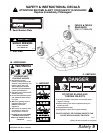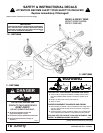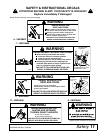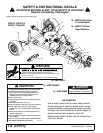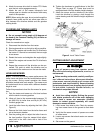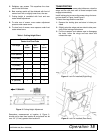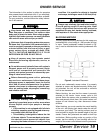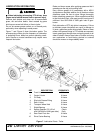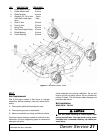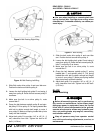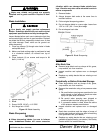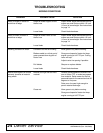
Operation 17
5WPMAN0183 (Rev. 4/25/2008)
Analyze area to be cut to determine the best proce-
dure. Consider height and type of grass and terrain
type: hilly, level, or rough.
Plan your mowing pattern to travel straight forward
whenever possible. Mow with uncut grass to the right.
This will distribute the clippings over the cut area.
Uneven Terrain
Do not operate or transport on steep slopes.
Do not stop, start, or change directions sud-
denly on slopes.
Use extreme care and reduce ground speed on
slopes and rough terrain.
Watch for hidden hazards on the terrain during
operation.
In extremely uneven terrain, rear wheel weights, front
tractor weights and/or front tire ballast should be used
to improve stability.
Pass diagonally through sharp dips and avoid sharp
drops to prevent hanging up the tractor and the mower.
Practice will improve your skills in maneuvering rough
terrain.
Avoid sudden starts and stops when traveling up or
down hill.
Always mow down slopes, never up or across the face.
Avoid operating on steep slopes.
Slow down on sharp turns and slopes to prevent tip-
ping and losing control.
REMOVING MOWER FROM TRACTOR
1. Park the unit on a level, hard surface with the
wings and rear deck fully lowered to the ground.
2. Block the wheels to keep the mower from rolling
when unhitched from tractor.
3. Attach the jack to the side of the tongue and adjust
the height to take the weight off the tractor hitch.
4. Disconnect the PTO shaft and the hydraulic hose,
untie the mower transport lock release rope from
the tractor, and remove the hitch pin.
5. Store the PTO shaft end and the hydraulic hose
couplings off the ground and keep them clean.
OWNER PRE-OPERATION CHECK LIST
(OWNER'S RESPONSIBILITY)
___ Review and follow all safety rules and safety
decal instructions on pages 5 through 12.
___ Check that all safety decals are installed and in
good condition. Replace if damaged.
___ Check that all shields and guards are properly
installed and in good condition. Replace if dam-
aged.
___ Check that chain shielding is in good condition
and replace any damaged chain links.
___ Check that all hardware and cotter pins are prop-
erly installed and secured.
___ Check to ensure blades are sharp, in good condi-
tion, and installed correctly. Replace if damaged.
___ Check that equipment is properly and securely
attached to tractor.
___ Make sure driveline spring-activated locking pin
or collar slides freely and is seated firmly in trac-
tor PTO spline groove.
___ Make sure the driveline guards and tether chains
are in good condition. Guards must rotate freely
on driveline. Fasten tether chains, as instructed,
to the tractor and the equipment.
___ Inspect area and remove stones, branches or
other hard objects that might be thrown, causing
injury or damage.
___ Do not allow riders.
___ Check all lubrication points and grease as
instructed in Lubrication Information, page 20.
Make sure the PTO slip joint is lubricated and that
the gearbox fluid levels are correct.
___ Check that all hydraulic hoses and fittings are in
good condition and not leaking before starting
tractor. Check that hoses are not twisted, bent
sharply, kinked, frayed or pulled tight. Replace
any damaged hoses immediately.
___ Make sure tractor ROPS or ROPS CAB and seat
belt are in good condition. Keep seat belt
securely fastened during operation.
___ Before starting engine, operator must be in trac-
tor seat with seat belt fastened. Place transmis-
sion in neutral or park, engage brake and
disengage tractor PTO.



